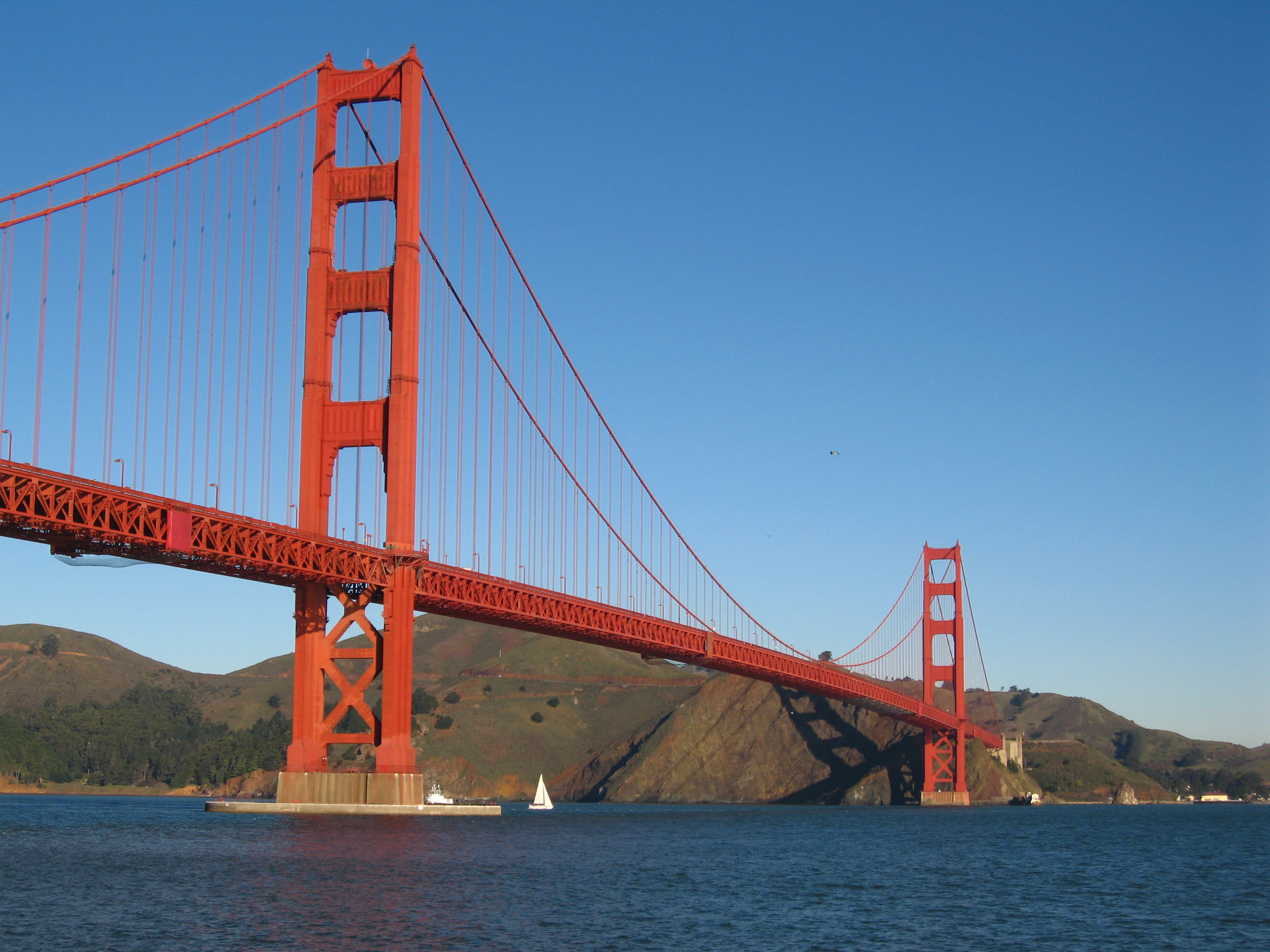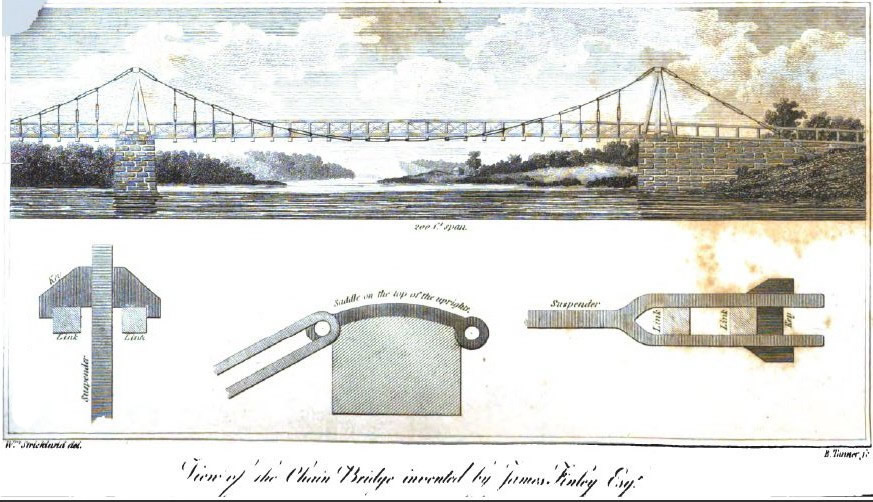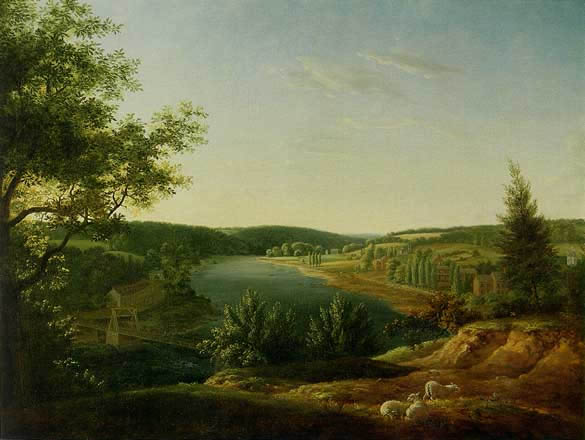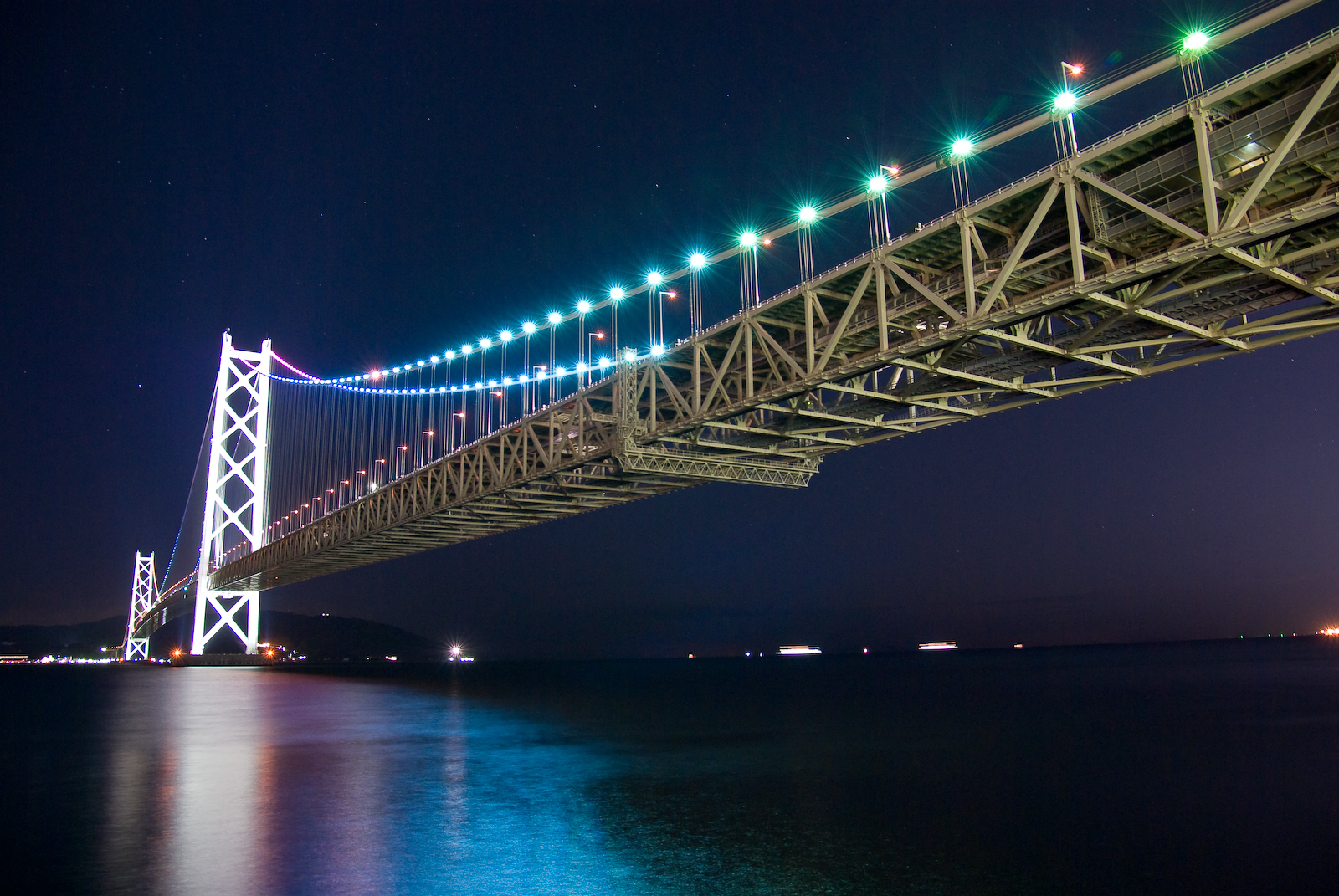
When hearing of the Golden Gate Bridge, most Americans picture its slender arching cables hanging from two tall, ruby red towers. At the time of its completion in 1937, this impressive suspension bridge was the longest of its type, spanning nearly 4,200 feet, and was considered the best of its time. While this bridge is located in California, the technology that made the bridge possible can be traced to a small bridge built over Jacob’s Creek in Westmoreland County and a judge with a passion for engineering.
James Finley was born in Ireland in 1756 to Scotch Irish parents who had immigrated to the United States. Little is known regarding Finley’s education during his childhood and young adulthood. Historian Eda Kranakis reports that he is described by friend and Fayette County treasurer Ephraim Douglass as having had an “English” education—one which focused on the importance of English literature and science. Finley also may have attended a Presbyterian school which would have taught him reading, writing, and arithmetic while introducing him to broad ideas in philosophy and science. In the years prior to 1784, Finley moved to Fayette County, near Uniontown, to try his hand at farming. The land itself seemed promising as a resident of Uniontown wrote: “I can say little of the country in general but that it is very poor in everything but soil, which is excellent.”
Within his first few years in Uniontown, Finley became a successful politician—a path that would open several economic and social doors to him. In 1784, Finley was elected justice of the peace. Five years later, Finley was elected as county commissioner, and served two years in the state House of Representatives, starting in 1790. 1793 saw the now successful Finley named to the Pennsylvania State Senate. Amid Finley’s multiple elections, he was also named the associate judge for Fayette County—a position he held for the rest of his life. As a result of his highly successful political career, Finley saw benefits in his economic standing, as he was one of the wealthiest men in Fayette County.
Although he was an affluent politician, Finley was interested in the opinions of all he encountered. Whether it was a fellow politician or a fellow farmer, Finley was sure to find a common thread amongst all his neighbors. The connections between such a diverse group of people can be attributed to their love for science and technology. Kranakis writes that “Practical Science,” or a science focused on commercial and technological concerns, is often what brought all of these groups together. Friends knew they could turn to Finley when it came to science, and they often did. One notable instance is when Ephraim Douglass turned to Finley regarding a frost which blanketed the area, killing local fruit trees. Douglass wanted Finley to use his influence to question the American Philosophical Society, the leading authority on all matters scientific in America and led by Benjamin Franklin, on whether an eclipse could be held responsible for the event.

Friends and colleagues turning to Finley with problems was nothing new to him. As a politician on both the local and state levels, Finley was met with several calls for improvements to various communities. Many of the requests came for roads and bridges to make travel easier between destinations. As county commissioner, responsibility fell on Finley to review proposals, find locations, and appropriate funding for these requests. At the state level, Finley had similar responsibilities. He likely would have been required to review proposals for various projects throughout the state—projects referred to as “internal improvements.” One of the most notable Finley encountered was the call for a state turnpike to decrease travel time between Pittsburgh and Philadelphia—a common trip for Finley when travelling from his home in Fayette County.
While this project was important regarding travel time, it was also responsible for exposing Finley to several different bridge designs. One group that advocated a new travel system was the “Improvement for Inland Navigation,” formed in 1791. They pushed for several designs, which would have exposed Finley to several bridge ideas. The proposed bridges for the project were varied in both plan and material. Most of the designs were arch bridges—bridges with curved arches beneath, distributing weight more evenly to vertical supports—to be built with either cast iron or wood. One notable plea came from Charles Willson Peale, a noted inventor and painter of the time, who had a wooden bridge design. Peale writes, “Legislatures, and you men of influence in the counties of each State! Turn your attention to this object—shorten your distance to market for the sale of the product of your lands, I offer you a cheap and easy mode of building Bridges.” The project ultimately relied on several designs, and in 1794, the first portion was complete—a new stretch of roads and bridges between Philadelphia and Lancaster.
During this time, Finley began designing his own bridges for practical use. Certainly, Finley had much influence from the designs he reviewed during his work with the state turnpike. Finley, however, also had influence from previous generations. Upon later observation, noted bridge builder Thomas Pope would describe the influence of older bridges on Finley. Pope writes, “Having also examined the account of one of the Chain Bridges erected in the East-Indies, we find by comparing them together, they perfectly agree.” From the modern influence of his time with the state turnpike to the classical influence from older structures, Finley had several ideas to which he could turn.

In designing his bridge, Finley adhered to a few principles. First, he wanted the bridge to be economically sensible in both construction and maintenance. Additionally, he wanted his bridge to be easy to construct and applicable to any site for implementation throughout the state. Finley conducted several experiments after his final term as state senator in 1793. Finley would hang weights from cables and observe the results, noting both pressure and movement. After years of testing designs through various experiments, Finley finally found a formula he was pleased with and in 1801, he publicly proposed his design. Finely went on to describe the design in 1810 in the political magazine The Port Folio:
The bridge is solely supported by two iron chains, one on each side, the ends being well secured in the ground, and the chains raised over piers of a sufficient height erected on the abutments at each side, extended so slack as to describe a curve, so that the two middle joists of the lower tier may rest on the chains.
Likely leveraging relationships forged in his political life, Finley obtained a contract to construct his bridge design over Jacob’s Creek. The creek ran between Uniontown in Fayette County and Greensburg in Westmoreland County, with the specific site being near the home of a friend close with Finley. This choice was likely to access the furnaces found in the home to aid in completing the ironwork—as iron was the main material used in the construction of the bridge. Upon completion in 1801, Finley’s bridge was approximately 13 feet wide and stretched nearly 70 feet across the creek. Most notably, Finley’s bridge cost $600. When inflation is taken into consideration, the cost today would be around $7,500. Unfortunately, Finley’s bridge across Jacob’s Creek was demolished in 1833 and replaced with a wooden bridge. Although gone, the legacy of the bridge lived on.
What made Finley’s bridge stand out most was that it was much stronger than the common wooden truss bridge of the time. In fact, Finley’s bridge was able to hold much more than its own weight. In The Port Folio, Finley gave a detailed description of how a bridge in his suspension design spanning 300 feet with a width of 30 feet would handle weight. The bridge itself would require 140 tons of material, but would ultimately be able to support 540 tons of weight. This would leave 400 tons of weight bearing ability—well over double its own weight.

While Finley’s bridge proved much better than wooden truss bridges, it also proved much more viable than the ancient suspension bridges which influenced it. One of the most noticeable differences of Finley’s bridge was that it had a solid and level horizontal deck. This improvement meant the bridge would be able to handle carts and other wheeled vehicles easily, as opposed to just simple foot traffic. Additionally, Finley’s bridge had support points for the cables at both ends of the bridge, not just one. This innovation allowed the weight to be distributed more evenly, resulting in more strength. Most importantly, Finley implemented support joists—beams running horizontally beneath the deck—to aid in bearing weight and to prevent waves in the bridge. When pressure is applied to the bridge deck, small waves are sent out from the point of contact, affecting the stability and shape of the deck. The joists ultimately helped in absorbing the force and ensuring the deck remained level. Also, the joists aided in wind protection, keeping the bridge and the deck in place against swaying.
Finley realized how innovative his bridge was and shortly after the completion of the Jacob’s Creek bridge, obtained a patent on the design in 1808. Patenting his design not only increased Finley’s notoriety, the patent also made him much wealthier. According to legal documents, Finley requested, “parties shall not grant permission to build bridges on this plan at less than one dollar per foot span, without any discrimination as to breadth.” The original patent, however, was lost to a fire in 1836. During this time, Finley’s patent was stored in a temporary facility while a new one was being built. The temporary facility caught fire and was unable to be put out in time due to water lines being frozen.
While Finley’s original patent was lost, he had published several accounts and descriptions of his bridge design. As a result, several bridges were built in this design—some by Finley, some by inspired others. Notable bridges include spans over the Potomac River in Chain Bridge, Virginia, the Lehigh River in Northampton, Pennsylvania, the Merrimack River in Newburyport, Massachusetts, and the Schuylkill River in Philadelphia, Pennsylvania. The bridge over the Schuylkill River—the Chain Bridge at the Falls of Schuylkill—was said to be a source of great pride for Finley. In all, approximately 40 bridges were constructed in line with Finley’s design.
Although Finley’s design was popular, some criticisms were present regarding originality and some design aspects, such as the joists. While some designers overlooked the criticisms, some did not, and instead ignored Finley’s methods. One common flaw was choosing more cable stabilization over the joists below the deck to support the bridge. This led to years of flawed bridge building and several bridge failures. Noted bridge designer Othmar Ammann reflected on the flawed bridges: “Had Finley’s sound principles of construction been adhered to, many of the early suspension bridge failures would have been avoided.” As a result, suspension bridges saw a slight decline until the 1840’s, when European implementations once again increased their popularity.
Even in the modern world, Finley’s ideas and designs are still appreciated. Historian Emory Kemp has noted, “In an age when master builders produced designs with little or no engineering sensibilities, Finley overcomes this lacuna in engineering design by producing a method for detailed analysis…” Perhaps one of the greatest acknowledgments to Finley in the modern world is that his designs are still being put to use today. Thousands of bridges today rely on the same suspension technology Finley used. In 1998, a bridge 6,500 feet in length was built in Japan. The Akashi Kaikyo Bridge, as it is called, is the longest suspension bridge in modern history. The bridge relies on several aspects of Finley’s original designs.
In a sense, Finley understood the importance and lasting ability of his bridge designs when he wrote, “There is no reasonable doubt, that in some extraordinary case this kind of bridge will be extended to one thousand feet, when the subject shall be fully understood.” He turned out to be right, as evidenced by the numerous suspension bridges spanning great lengths. As technology progresses, the future of suspension bridges remains limitless, as greater weights and greater lengths will continue to be pushed for. While new plateaus are continually reached, all suspension bridges will share that common ancestor—a 70 foot suspension bridge over Jacob’s Creek.
Sources:
- “Akashi Kaikyo Bridge.” HSBE: Honshu-Shikoku Bridge Expressway Company Limited. 21 June 2011 <http://www.jb-honshi.co.jp/english/technology/akashi.html>
- Finley, James. “A Description of the Patent Chain Bridge.” Port Folio. Jun 1810: 441-453.
- James, Peter. Ancient Inventions. New York, NY: Ballantine Books, 1995.
- Kranakis, Eda. Constructing a Bridge: An Exploration of Engineering Culture, Design, and Research in Nineteenth-Century France and America. Cambridge, MA: The MIT Press, 1997.
- Sayenga, Donald. “James Finley.” Structure. Nov. 2008. NCSEA. 21 June 2011 <http://www.structuremag.org/article.aspx?articleID=804>
- Strickland, William. “View of the Chain Bridge Invented by James Finley. Port Folio. June 1810.

